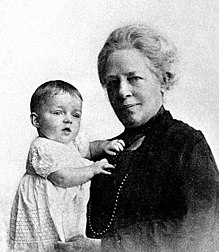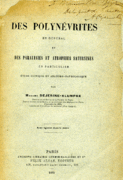Augusta Déjerine-Klumpke
Augusta Déjerine-Klumpke (born October 15, 1859 in San Francisco , California , † November 5, 1927 in Paris ) was an American-French neurologist who was known for her work in neuroanatomy and the first graduate of the boarding school des hôpitaux de Paris .
Life
Childhood and youth
Marie Augusta Klumpke was born in San Francisco in 1859 to parents of German origin. Her father Johan Gerard Klumpke (1825–1917), who originally came to California at the time of the gold rush and made a fortune there with real estate, and her mother, the painter Dorothea Mathilda Klumpke , née Tolle, († May 1922), married in 1855.
Augusta had a brother (* 1868) and four sisters, including Dorothea Klumpke (* 1861), later known as an astronomer, and the painter Anna Elizabeth Klumpke (* 1856). Her sister Julia (* 1870) later became a violinist and composer (pupil of Eugène Ysaÿe), sister Mathilda a pianist (pupil of Antoine François Marmontel).
When her parents got divorced, her mother moved with her and her siblings to Europe in April 1871, where they stayed in Germany and then in Clarens , Switzerland . Augusta was allowed to move to a boarding house for girls in Lausanne to begin her studies at the École Vinet, (École supérieure de jeunes filles) in August 1873. She wanted to study medicine, but since there was no medical faculty in Lausanne, the family moved to Paris on September 2, 1876, so that the siblings could study according to their inclinations.
Medical and scientific activity
Despite the resistance of the dean of the faculty, Edmé Félix Alfred Vulpian , who refused her because she was a woman and also very young, Augusta was able to start studying at the medical faculty of Paris in 1876, the only one where women were at the time could enroll. At the same time, she attended courses at the Sorbonne, with Louis-Antoine Ranvier at the Collège de France and with Edmond Frémy , who founded the first laboratory in France (in the Muséum national d'histoire naturelle ) dedicated exclusively to study and scientific research .
She completed her clinical training at several Parisian clinics: at the Hôpital de la Pitié with Étienne Lancereaux , Théophile Gallard, Sigismond Jaccoud, at the Hôpital Saint-Louis with T. Terraillon, at the Hôpital Lariboisière with Simon-Emmanuel Duplay, at the Hôpital des Quinze- Vingts with Theodore Edouard Fieuzal. She also attended the clinical lectures of Jean-Martin Charcot at the Hôpital de la Salpêtrière and those of Valentin Magnan at the Center hospitalier Sainte-Anne. Between 1881 and 1882 she completed an internship in the medical clinic of Professor Hardy at the Hôpital de la Charité , in 1882 she was in training at the Hôpital Saint-Louis in the service of Dr. Porak and Professor Grancher.
During her work at the Hôpital Saint-Louis in 1880, Klumpke made the acquaintance of her future husband, the neurologist Joseph Jules Dejerine , who had noticed her outstanding abilities during her studies and wrote about her: "Elle a toutes les qualités possibles". During her second and third years, Augusta was associated with the Vulpian Clinic. During this time, in 1885, she described a form of childhood plexus palsy , known today as Klumpke's arm paralysis (Klumpke lower plexus paralysis), an injury to the nerves that control arm movement and which occurs more frequently after breeches . In 1986 she published her work on paralysis after lead poisoning .
In order to be able to begin her specialist training, she had to qualify against other competitors in 1885 by taking an exam at the boarding school des hôpitaux de Paris , a vocational training system at the time that enabled specialist doctors to be trained in Paris from 1802 to 2004. In the entrance examination she achieved 29 out of 30 points in the written part for the topic “Circonvolutions de l'écorce cérébrale, signes et causes de l'hémiplégie organique”, but the jury did not want to give her the necessary minimum number of points in the oral part. The next year she took the exam again, but this time received support from the then education minister and advocate of women's emancipation Paul Bert . Klumpke received her doctorate in 1889 with the thesis paper Des Polynévrites en général et des paralysies et atrophies saturnines en particulier .
Klumpke and Dejerine married in 1888. The marriage marked the beginning of a fruitful collaboration in neurological research. Without an official position, she concentrated on her neurological examinations, which she carried out at the clinics where her husband worked: from 1887 to 1894 he headed the neurological clinic in Hôpital Bicêtre and from 1894 the clinic of the Pavillon Jacquart at the Hôpital Salpêtrière . Augusta Dejerine-Klumpke made important contributions to the neuropathological writings of her husband and was involved in the professional supervision of his students. She was an experienced and gifted illustrator, designed schematic diagrams, and demonstrated a tremendous dexterity in cutting microscopic specimens from the central nervous system . She published a large number of neurological articles under her own name and with her colleagues. During her lifetime, her name appeared in fifty-five articles, some of which she wrote herself. Together with her husband Joseph Jules Dejerine, she wrote a two-volume book on the anatomy of nerve centers in 1895, called Anatomie des Centes Nerveux , which was reprinted in 1980.
During the First World War and the following years, she pioneered the treatment and rehabilitation of soldiers with injuries to the nervous system and especially the spinal cord. Most of her clinical and pathological findings were published in 1914 in La Sémiologie des affections du système nerveux .
After the death of her husband in February 1917, she worked with her daughter, who was also a doctor, and her son-in-law Étienne Sorrel, professor at the Berck Hospital , at the Paris Faculty of Medicine on the establishment of the Musée Dejerine with a library for the preservation of her scientific knowledge Estate and set up a neurological laboratory.
Klumpke was a member of several scientific societies, including the Société de Biologie and as the first woman of the Société de Neurologie de Paris , of which she was president in 1914/1915. In 1913 Augusta Dejerine-Klumpke was appointed Chevalier de la Légion d'honneur (Ch. LH) , and in 1921 as Officier de la Légion d'Honneur (O. LH) . Sick of breast cancer, she died on November 5, 1927 and was buried next to her husband in the Père Lachaise cemetery.
Fonts (selection)
- Des polynévrites en général et des paralysies et atrophies saturnines en particulier. Doctoral thesis, Alcan, 1889, 295 pages archive.org (reprint: Nabu Press, 1st edition 2013, ISBN 978-1-289-67393-2 ).
- Anatomy of the centers nerveux . With Joseph Jules Dejerine, 2 volumes, Paris, 1895 (Volume I archive.org , Volume II archive.org ) and 1901.
- Sémiologie des affections du système nerveux . With Joseph Jules Dejerine, Ed. Masson, Paris, 1914 (digitized) .
literature
- Johannes Oehme: pioneers of paediatrics . Topics of Pediatrics, Volume 7. Hansisches Verlagkontor Lübeck, 1993, ISBN 3-87302-076-9 , p. 53
- Catharine MC Haines: International Women in Science: A Biographical Dictionary to 1950 . ABC-Clio, Santa Barbara 2001, ISBN 978-1-57607-090-1 , p. 84 ( books.google.de ).
- Julien Bogousslavsky: The Swiss connection of Augusta Déjerine-Klumpke. Swiss archive for neurology, psychiatry and psychotherapy. Issue 1, 2011, pp. 37-41
Web links
- Ole Daniel Enersen: Whonamedit? A dictionary of medical eponyms. Augusta Marie Dejerine-Klumpke . Retrieved April 4, 2017.
- Bibliothèque de l'Académie nationale de médecine: Portrait 2: Augusta Dejerne née Klumpke (1859-1927) . Retrieved April 5, 2017.
- S. Karger : The Klumpke Family - Memories by Doctor Déjerine, Born Augusta Klumpke . Retrieved January 12, 2018
- Digital copies under "biusante.parisdescartes.fr" for Augusta Dejerine-Klumpke and for Jules Dejerine . Retrieved January 13, 2018.
Individual evidence
- ↑ Klumpke, Augusta . In: Hans Vollmer (Hrsg.): General lexicon of fine artists from antiquity to the present . Founded by Ulrich Thieme and Felix Becker . tape 20 : Kaufmann – Knilling . EA Seemann, Leipzig 1927, p. 556 .
- ^ Mary RS Creese: Ladies in the Laboratory II: West European Women in Science, 1800-1900. Scarecrow Press, 2004, ISBN 978-0-8108-4979-2 , pp. 79-80 ( books.google.de ).
- ^ A b Kathleen Adler, Erica E. Hirshler, H. Barbara Weinberg: Americans in Paris, 1860–1900 (National Gallery London) . Yale University Press, London 2006, ISBN 1-85709-301-1 , p. 248.
- ↑ medarus.org: Augusta Marie Klumpke épouse Déjerine. Retrieved April 5, 2017.
- ^ Mary RS Creese: Ladies in the Laboratory II: West European Women in Science, 1800-1900 . Scarecrow Press, 2004, ISBN 978-0-8108-4979-2 , p. 57 ( books.google.de ).
- ^ Rudolf Degkwitz et al. (Ed.): Mentally ill; Introduction to Psychiatry for Clinical Study. Urban & Schwarzenberg, Munich 1982, ISBN 3-541-09911-9 , page 459
- ^ Mary RS Creese: Ladies in the Laboratory II: West European Women in Science, 1800-1900. Scarecrow Press, 2004, ISBN 978-0-8108-4979-2 , p. 63 ( books.google.de ).
- ↑ B. Schurch, P. Dollfus: The 'Dejerines': an historical review and homage to two pioneers in the field of neurology and their contribution to the understanding of spinal cord pathology. In: Spinal cord. Volume 36, Number 2, February 1998, pp. 78-86, PMID 9494995 .
- ^ Mary RS Creese: Ladies in the Laboratory II: West European Women in Science, 1800-1900. Scarecrow Press, 2004, ISBN 978-0-8108-4979-2 , p. 63 ( books.google.de ).
| personal data | |
|---|---|
| SURNAME | Déjerine-Klumpke, Augusta |
| ALTERNATIVE NAMES | Klumpke, Augusta |
| BRIEF DESCRIPTION | American-French neurologist |
| DATE OF BIRTH | October 15, 1859 |
| PLACE OF BIRTH | San Francisco , California |
| DATE OF DEATH | November 5, 1927 |
| Place of death | Paris |










